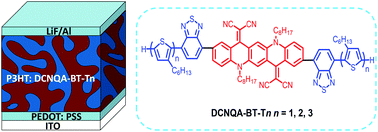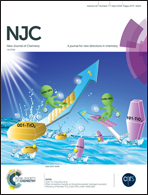Benzothiadiazole-oligothiophene flanked dicyanomethylenated quinacridone for non-fullerene acceptors in polymer solar cells†
Abstract
A new class of benzothiadiazole-oligo(3-hexylthiophene) flanked dicyanomethylenated quinacridone derivatives DCNQA-BT-Tn (n = 1–3) has been designed and synthesized in good yield by iterative bromination and Suzuki coupling reactions, followed by Knoevenagel condensation. The photophysical and electrochemical properties of the compounds have been fully investigated. They showed intense and broad absorption at the visible and near-infrared regions, a suitable LUMO energy level at about −3.7 eV, and the appropriate film-formation properties. The bulk heterojunction (BHJ) photovoltaic devices based on the blend film of P3HT/DCNQA-BT-T1 (P3HT = poly(3-hexylthiophene)) showed a power conversion efficiency (PCE) of 0.73% under AM 1.5, 100 mW cm−2 irradiation. Compared with the traditional P3HT/PC61BM (PC61BM = [6,6]-phenyl-C61-butyric acid methyl ester) device, the P3HT/DCNQA-BT-T1 device displayed intense absorption in the near-infrared region (650–750 nm) and effectively contributed to the photocurrent. These results indicate that DCNQA derivatives are promising non-fullerenes acceptors for the BHJ polymer solar cells.



 Please wait while we load your content...
Please wait while we load your content...